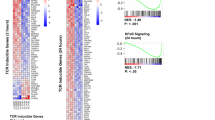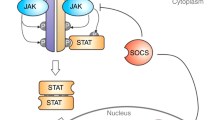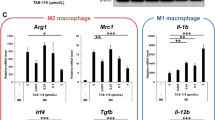Abstract
Sorafenib, a novel drug for metastatic renal cancer, has broad-spectrum activity against multiple tyrosine kinases, including Raf-1, vascular endothelial growth factor receptor and platelet-derived growth factor receptor. However, little is known about its effects on the immune system. In this report, we examine the effects of sorafenib on the proliferation and activation of human peripheral blood T cells, as well as its effects on T-cell-mediated immune response in mice. At concentrations similar to those used in patients, sorafenib inhibited the proliferation of primary human T cells in vitro. At more than 10 μM, sorafenib caused an irrecoverable inhibition of proliferation, even after drug withdrawal. In addition, sorafenib induced T-cell apoptosis at concentrations higher than 10 μM. sorafenib also caused G0/G1 phase arrest, inhibition of CD25 and CD69 expression, interleukin-2 production and LCK phosphorylation in the T cells; all of these effects exhibited dose and time dependence. When tested against contact dermatitis in mice, sorafenib significantly reduced the ear swelling induced by picryl chloride. These findings suggest that sorafenib may cause the loss of T-cell immune response by inducing apoptosis and targeting LCK. This could potentially lead to immunosuppression in patients with cancer.
This is a preview of subscription content, access via your institution
Access options
Subscribe to this journal
Receive 12 print issues and online access
$259.00 per year
only $21.58 per issue
Buy this article
- Purchase on Springer Link
- Instant access to full article PDF
Prices may be subject to local taxes which are calculated during checkout







Similar content being viewed by others
References
Wilhelm S, Chien DS . BAY 43-9006: preclinical data. Curr Pharm Des 2002; 8: 2255–2257.
Ahmad T, Eisen T . Kinase inhibition with BAY 43-9006 in renal cell carcinoma. Clin Cancer Res 2004; 10: 6388S–6392S.
Wilhelm SM, Carter C, Tang L, Wikie D, McNabola A, Rong H et al. BAY 43-9006 exhibits broad spectrum oral antitumor activity and targets the RAF/MEK/ERK pathway and receptor tyrosine kinases involved in tumor progression and angiogenesis. Cancer Res 2004; 64: 7099–7109.
Auclair D, Miller D, Yatsula V, Pickett W, Carter C, Chang Y et al. Antitumor activity of sorafenib in FLT3-driven leukemic cells. Leukemia 2007; 21: 439–445.
Lierman E, Lahortiga I, Van Miegroet H, Mentens N, Marynen P, Cools J . The ability of sorafenib to inhibit oncogenic PDGFRbeta and FLT3 mutants and overcome resistance to other small molecule inhibitors. Haematologica 2007; 92: 27–34.
Guida T, Anaganti S, Provitera L, Gedrich R, Sullivan E, Wihelm SM et al. Sorafenib inhibits imatinib-resistant KIT and platelet-derived growth factor receptor beta gatekeeper mutants. Clin Cancer Res 2007; 13: 3363–3369.
Lierman E, Folens C, Stover EH, Mentens N, Van Miegroet H, Scheers W et al. Sorafenib is a potent inhibitor of FIP1L1-PDGFRalpha and the imatinib-resistant FIP1L1-PDGFRalpha T674I mutant. Blood 2006; 108: 1374–1376.
Hommes DW, Peppelenbosch MP, Deventer SJH . Mitogen activated protein (MAP) kinase signal transduction pathways and novel anti-inflammatory targets. Gut 2003; 52: 144–151.
Dumont FJ, Staruch MJ, Fischer P, DaSilva C, Camacho R . Inhibition of T-cell activation by pharmacologic disruption of the MEK1/ERK MAP kinase or calcineurin signaling pathways results in differential modulation of cytokine production. J Immunol 1998; 160: 2579–2589.
Williams DH, Wilkinson SE, Purton T, Lamont A, Flotow H, Murray EJ . Ro 09-2210 exhibits potent anti-proliferative effects on activated T cells by selectively blocking MKK activity. Biochemistry 1998; 37: 9579–9585.
Lokich J . Spontaneous regression of metastatic renal cancer. Case report and literature review. Am J Clin Oncol 1997; 20: 416–418.
Nel AE . T-cell activation through the antigen receptor, part 1: signaling components, signaling pathways, and signal integration at the T-cell antigen receptor synapse. J Allergy Clin Immunol 2002; 109: 758–770.
Lin J, Weiss A . T-cell receptor signalling. J Cell Sci 2001; 114: 243–244.
Brenchley JM, Douek DC, Ambrozak DR, Chatterji M, Betts MR, Davis LS et al. Expansion of activated human naive T-cells precedes effector function. Clin Exp Immunol 2002; 130: 432–440.
Haque SJ, Wu Q, Kammer W, Friedrich K, Smith JM, Kerr IM et al. Receptor-associated constitutive protein tyrosine phosphatase activity controls the kinase function of JAK1. Proc Natl Acad Sci USA 1997; 94: 8563–8568.
Kearney ER, Pape KA, Loh DY, Jenkins MK . Visualization of peptide-specific T-cell immunity and peripheral tolerance induction in vivo. Immunity 1994; 1: 327–339.
Strumberg D, Clark JW, Awada A, Moore MJ, Richly H, Hendlisz A et al. Safety, pharmacokinetics, and preliminary antitumor activity of sorafenib: a review of four phase I trials in patients with advanced refractory solid tumors. Oncologist 2007; 12: 426–437.
Rini BI . Sorafenib. Expert Opin Pharmacother 2006; 7: 453–461.
Amato RJ, Harris P, Dalton M, Khan R, Alter Q, Zhai J et al. A phase II trial of intra-patient dose-escalated sorafenib in patients (pts) with metastatic renal cell cancer (MRCC). J Clin Oncol 2007; 25 (suppl 18): abstract (5026).
Gollob JA, Wilhelm S, Carter C, Kelley SL . Role of Raf kinase in cancer: therapeutic potential of targeting the Raf/MEK/ERK signal transduction pathway. Semin Oncol 2006; 33: 392–406.
Escudier B, Lassau N, Angevin E, Soria JC, Chami L, Lamuraglia M et al. Phase I trial of sorafenib in combination with IFN alpha-2a in patients with unresectable and/or metastatic renal cell carcinoma or malignant melanoma. Clin Cancer Res 2007; 13: 1801–1809.
Acknowledgements
This work was supported by National Science Foundation of China no. 30730107, the 973 Program of China no. 2002CB513000 and the Provincial Science Foundation of Jiangsu no. BK2007246. This study was carried out in Nanjing University.
Author information
Authors and Affiliations
Corresponding author
Additional information
Supplementary Information accompanies the paper on the Leukemia website (http://www.nature.com/leu)
Rights and permissions
About this article
Cite this article
Zhao, W., Gu, Y., Song, R. et al. Sorafenib inhibits activation of human peripheral blood T cells by targeting LCK phosphorylation. Leukemia 22, 1226–1233 (2008). https://doi.org/10.1038/leu.2008.58
Received:
Revised:
Accepted:
Published:
Issue Date:
DOI: https://doi.org/10.1038/leu.2008.58
Keywords
This article is cited by
-
Sorafenib inhibits interferon production by plasmacytoid dendritic cells in hepatocellular carcinoma
BMC Cancer (2022)
-
Hyperprogressive disease after radiotherapy combined with anti-PD-1 therapy in renal cell carcinoma: a case report and review of the literature
BMC Urology (2021)
-
Novel combinatorial strategies for boosting the efficacy of immune checkpoint inhibitors in advanced breast cancers
Clinical and Translational Oncology (2021)
-
Targeting tumour microenvironment by tyrosine kinase inhibitor
Molecular Cancer (2018)
-
Tyrosine kinase inhibition increases the cell surface localization of FLT3-ITD and enhances FLT3-directed immunotherapy of acute myeloid leukemia
Leukemia (2018)



